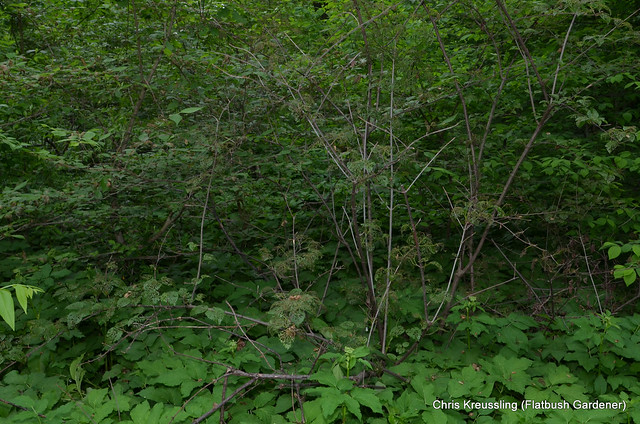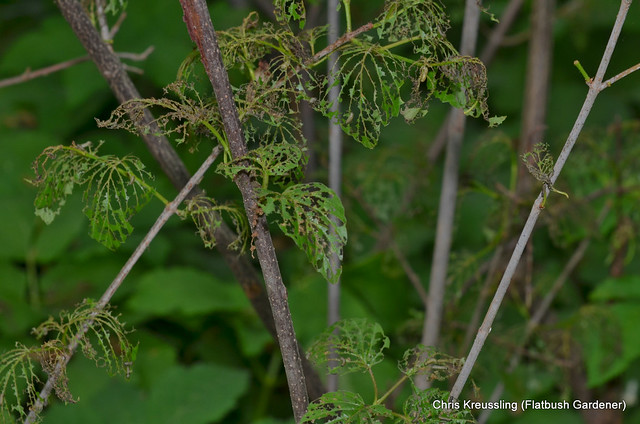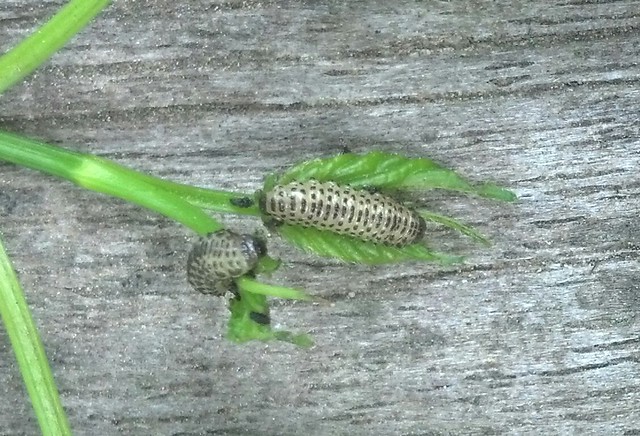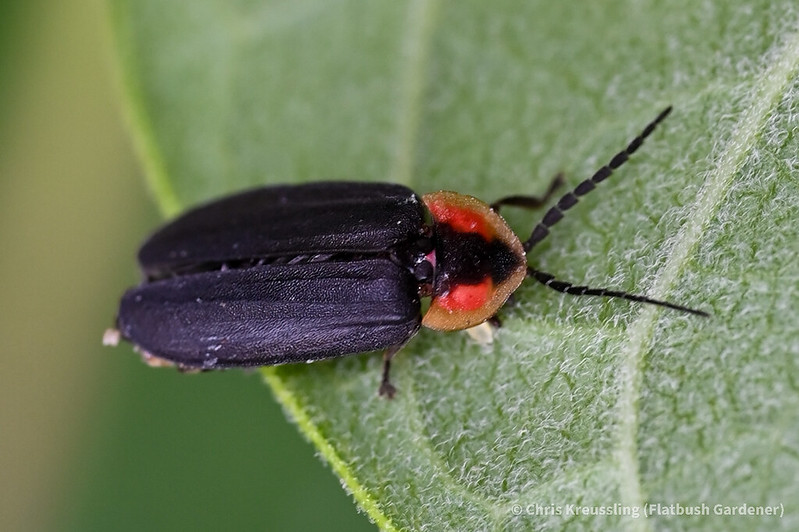Pyrrhalta viburni, the viburnum leaf beetle, or VLB for short, is native to Europe. It was first discovered in North America barely two decades ago, in Maine in 1994. Both larvae and adults eat leaves. Our native Viburnum species are extremely vulnerable; they aren’t adapted to this species of leaf beetle. With ample food supply, and no native predators to control its spread, VLB has rapidly expanded its range since.
The viburnum leaf beetle, Pyrrhalta viburni (Paykull), is an invasive, non-native beetle that first appeared in New York along Lake Ontario in 1996, and has steadily spread across the state and down the Hudson Valley. It is a voracious eater that can defoliate viburnum shrubs entirely. Plants may die after two or three years of heavy infestation, particularly when larvae strip plants after hatching out in spring followed by heavy adult feeding later in summer.
– Viburnum leaf beetle invading NYC?, Cornell Horticulture Blog, May 2009
It’s been in New York City less than a decade. In Brooklyn, I first observed the damage on Viburnum dentatum, arrowwood, at the Brooklyn Botanic Garden in May 2012. Last year, I found it in Prospect Park; by May, arrowwoods there were shredded.



I’ve seen light damage on my large arrowwood for the past few years. I’ve suspected VLB, but never observed it. I’m ~1/2 mile south of Prospect Lake in Prospect Park, so it should be here. This Spring, I finally found it.
Pyrrhalta viburni, viburnum leaf beetle (VLB), 3rd instar larva, feeding on Viburnum dentatum, arrowwood, from my backyard, May 2015

Despite the fact I’ve made no special efforts to control or contain it, VLB has not gotten out of control on my single shrub. I have some hypotheses about why that might be.
Ecotype
My specimen is a cultivar, sold as ‘Blue Muffin.’ I suspect the plants in Prospect Park are local ecotypes planted as part of the woodlands restorations. When we select cultivars for horticultural characteristics, we select away from ecological value. It could be that this cultivar has some natural resistance to VLB.
Exposure
The shredded arrowwoods in Prospect Park were growing in forest shade. Mine is growing in nearly full sun. The little damage I see on my shrub occurs only on the lower leaves; upper leaves don’t appear affected. From what I’ve read, this makes a difference, though the reasons are unclear.
Density
My specimen has never fruited well. I suspect this is due to the lack of arrowwoods in other gardens nearby. This low density could affect the ability of VLB to establish a viable population that can explode to the levels I’ve observed in Prospect Park.
Predation
I specialize in gardening with native plants, and have lots of habitat in my smallish urban garden. There are likely many native predators existing in the landscape that can predate on VLB. I suspect the prevalence of natural predators in my garden have kept them in check the past few years.
By planting a wide variety of native plants, especially plants from the Asteraceae and Apiaceae, we can provide shelter and food for these insects, keeping them around for when VLB emerges.
Related Content
Viburnum Leaf Beetle reaches New York City, 2009-05-28
Viburnum dentatum, Arrowwood, 2009-04-20
Links
Viburnum leaf beetle invading NYC?, Cornell Horticulture Blog, 2009-05-22
Predation by Podisus maculiventris (Say) (Hemiptera: Pentatomidae) on Viburnum Leaf Beetle, Pyrrhalta viburni (Paykull) (Coleoptera: Chrysomelidae), Under Laboratory and Field Conditions, Gaylord Desurmont , Paul A. Weston, Environmental Entomology, Volume 37, Issue 5, pp. 1241 – 1251
Viburnum leaf beetle, Department of Horticulture, Cornell University
Viburnum Leaf Beetle – Pyrrhalta viburni, Maine Department of Agriculture, Conservation and Forestry







